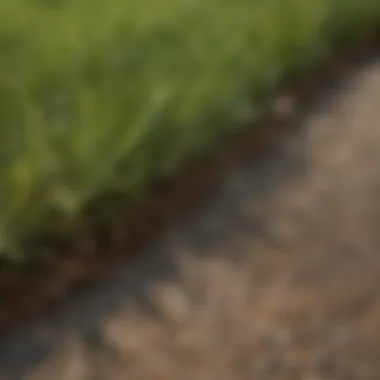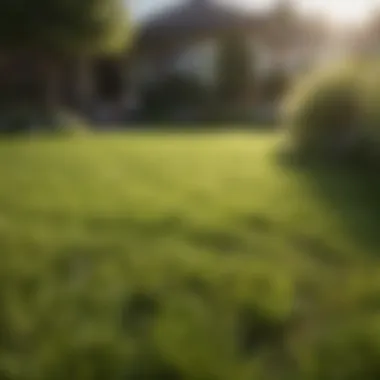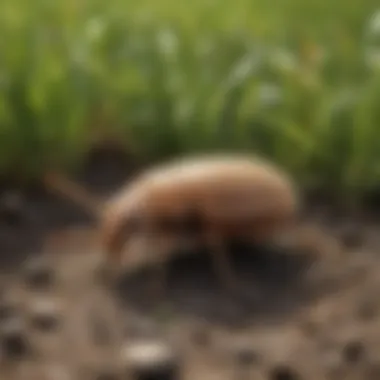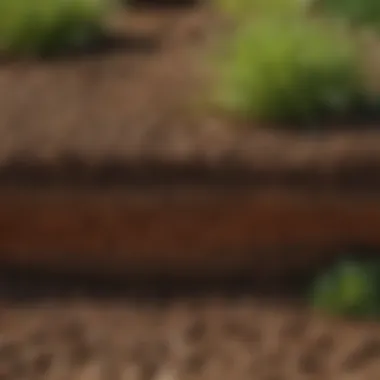Effective Solutions for Brown Spots in Lawns


Intro
Brown spots in lawns are a common concern that many homeowners and landscape professionals face. These unsightly patches can indicate underlying issues, ranging from simple environmental stress to severe pest infestations. Understanding the root causes is essential for effective remediation and maintaining a healthy lawn. This article aims to explore the various causes of brown spots, outline strategies for identification, and recommend solutions for prevention and treatment. It is intended for agriculture farmers and lawn care enthusiasts who wish to deepen their knowledge and improve their landscape management techniques.
Key Concepts and Terminology
Basic Definitions
To grasp the subject, it is crucial to understand some basic terms. Brown spots refer to areas on a lawn that lose color and vitality, often turning yellow or brown. These spots can be caused by a variety of factors. Soil health is another term frequently mentioned; it encompasses the biological, physical, and chemical qualities of the soil that affect plant growth. Proper soil health is often a key factor in preventing brown spots.
Historical Context
Historically, lawns have been integral to garden aesthetics, dating back to ancient civilizations. The maintenance of a lawn was once a sign of social status. Over the decades, however, the focus has shifted towards sustainability in lawn care. Understanding soil composition and the interaction with environmental factors has gained importance.
Recent Innovations and Trends
Technological Advancements
Technological innovations have greatly impacted lawn care strategies. For instance, soil sensors can detect moisture levels, helping farmers determine when irrigation is necessary. Advanced fertilizers that release nutrients over time can also prevent the yellowing of grass. Digital platforms offer guidance on lawn care routines, enhancing the understanding of when to seed, fertilize, and water the lawn.
Sustainable Practices
Sustainability is becoming increasingly relevant in lawn management. An emphasis on native grass species and organic fertilizers minimizes adverse environmental impacts. Practices such as mulching, composting, and using rainwater for irrigation are gaining popularity. These methods not only support soil health but can prevent brown spots by creating a resilient ecosystem.
Practical Applications and Techniques
Step-by-step Guides
- Assessment: Begin by examining the lawn for consistent patterns in the brown spots. Identify if certain areas are affected more than others.
- Soil Testing: Conduct a soil test to determine pH levels, nutrient availability, and contaminants. This informs any necessary amendments.
- Pest Inspection: Monitor for signs of pests. Look for irregularities such as wilted grass or visible insects.
- Watering Schedule: Implement a consistent watering schedule. Adjust it based on seasonal requirements and precipitation levels.
- Fertilization: Use slow-release fertilizers to maintain nutrient levels without overwhelming the grass.
- Aeration: Aerate the lawn to improve nutrient and water absorption.
Case Studies
Various practical examples can help illustrate effective methods in combatting brown spots. In one instance, a homeowner discovered that their brown spots were caused by grubs. After applying a targeted insecticide and enhancing soil health with compost, the lawn improved significantly. Another case showed that a farmer faced patches caused by dry soil. Implementing a rainwater catchment system led to even distribution of moisture and eliminated brown spots.
Understanding the causes of brown spots is crucial for sustainable lawn care.
Understanding Brown Spots in Lawns
Brown spots in lawns represent a common concern for many property owners and landscapers. This section is critical because it establishes a baseline understanding of brown spots, how they form, and their implications for lawn health. Recognizing the nature of these discolorations can empower homeowners to take action. The presence of brown patches typically indicates underlying issues that need to be addressed promptly to maintain a lush and visually appealing landscape.
Definition of Brown Spots
Brown spots in lawns can be defined as areas of grass that have turned brown or yellow, indicating an unhealthy state or stress. These discolorations can vary in size and shape, appearing as small patches or larger, more irregular areas. Various factors contribute to the formation of brown spots, including inadequate watering, pest infestations, and soil issues. Understanding these definitions and contexts provides clarity on the complexities involved in lawn care.
Common Misconceptions
Misconceptions surrounding brown spots can hinder effective treatment and prevention. Here are some common misunderstandings:
- Only pests cause brown spots: Many believe that only insects are responsible. However, environmental factors like water management play a significant role.
- Brown spots are only present in summer: People often think brown spots only appear in hot months, while they can result from winter stress or even springtime conditions.
- Overwatering is never a problem: Some homeowners are under the impression that more watering is better. Yet, excessive moisture can cause root rot and other issues.
Understanding these misconceptions is crucial for adopting effective lawn care practices. Identifying the real causes behind brown spots ensures strategies are aligned with the right issues.
Identifying Causes of Brown Spots
Understanding the reasons behind brown spots in lawns is crucial for effective treatment and prevention. It helps in targeting the right solutions and can save time and resources. A well-informed approach allows homeowners and professionals to maintain a healthy, vibrant lawn. Identifying the causes clearly can lead to better outcomes and improve lawn aesthetics.


Environmental Factors
Insufficient Watering
Insufficient watering is a common issue that contributes to the formation of brown spots. It occurs when grass does not receive enough moisture for growth. Grass begins to wilt or dry out, leading to discoloration. One key characteristic of insufficient watering is the uneven appearance of the lawn. Some areas may look parched while others thrive, creating a patchy landscape. This aspect makes it a popular consideration in the article.
The unique feature of insufficient watering is its immediate visual impact. A grass lawn needs consistent moisture, especially during hotter months. Its disadvantages include the need for more frequent watering schedules and the potential for higher water bills if not managed correctly. Adjusting watering habits can lead to healthier grass and reduce brown spots.
Excessive Watering
On the opposite end, excessive watering can also create brown spots. When lawns are over-watered, they can develop a range of problems related to drainage and root health. A key characteristic of excessive watering is the saturation of soil, which can drown grass roots. This makes it a relevant topic in lawn care discussions.
Excessive watering can lead to unique challenges, such as increased risk of fungal diseases. Furthermore, it creates a very muddy environment that is not only unsightly but can also attract undesirable pests. To mitigate these effects, establishing a watering routine that meets the grass's needs is paramount.
Temperature Fluctuations
Temperature fluctuations refer to the significant changes in temperature that can affect grass health. Sudden cold snaps or heat waves can stress the lawn, resulting in brown spots. A key characteristic is that grass can react poorly to these extremes, causing uneven growth. This issue brings depth to discussions in the article.
The unique nature of temperature fluctuations lies in their unpredictability. These changes can vary from week to week, making it difficult for homeowners to adapt their care routines. Grass may show signs of distress quickly due to sudden exposure to extreme temperatures. As long-term strategies evolve, understanding these fluctuations can help in preserving lush lawns.
Pest Infestations
Grubs and Other Insects
Grubs and other insects are often overlooked contributors to brown patches in lawns. These pests feed on grass roots, causing significant damage. A key characteristic of grubs is their tendency to create uneven patches as they eat through the root system. They are an important consideration when assessing lawn health.
The unique feature of grubs is their lifecycle. They can be difficult to detect until substantial damage has occurred. The main advantage of understanding grub presence is that identifying them early can lead to effective treatments. This can help restore lawn health and prevent further infestations.
Nematodes
Nematodes are microscopic worms that can also cause brown spots. They invade grass roots and lead to stress on the plants. The key characteristic of nematodes is their abiility to reproduce quickly, often resulting in widespread issues across lawns. Their significance makes them a common topic in pest discussions.
One unique aspect of nematodes is their ability to thrive in various soil conditions. While they may be beneficial in some cases, their presence can lead to unfavorable outcomes in lawns. Being aware of their effects means early detection and targeted control measures can be put in place. This contributes to overall lawn health.
Fungal Diseases
Fungal diseases pose another significant risk for lawns, directly leading to brown spots. These diseases thrive in certain environmental conditions, often becoming prevalent during hot, humid weather. Their key characteristic is their ability to spread rapidly across a lawn. This makes their identification crucial in preventing larger issues.
Fungal diseases have unique traits, such as specific symptoms like patches and unusual growth patterns. Understanding fungal behavior is advantageous as it leads to better preventive measures. Such proactive approaches can save considerable time and effort in recovery, ensuring robust lawn growth.
Soil Quality Issues
Nutrient Deficiency
Nutrient deficiency directly affects grass growth and vibrancy. When soil lacks essential nutrients, grass cannot perform optimally, leading to brown spots. A key characteristic is the pale appearance of grass in affected areas. This makes nutrient management essential in lawn care.
The unique feature of nutrient deficiency is that it can stem from various factors, including poor soil health or improper fertilization. Understanding these deficiencies leads to actionable steps such as soil testing and amendment. Addressing nutrient issues can have substantial long-term impacts on lawn quality.
Soil Compaction
Soil compaction occurs when soil particles are pressed together, reducing pore space. This limits the ability of grass roots to access nutrients and water. A key characteristic of compaction is the hard, impenetrable soil, which can make it difficult for grass to thrive. Its importance is underscored in discussions of lawn maintenance techniques.
The unique aspect of soil compaction is its gradual build-up over time, often due to foot traffic or heavy machinery. Identifying and remedying compaction involves aeration methods, which can greatly improve soil structure. Taking steps to alleviate compaction promotes healthier lawns.
pH Imbalance
Soil pH imbalance refers to an inappropriate level of acidity or alkalinity in the soil. This imbalance prevents grass from absorbing essential nutrients. A key characteristic of pH imbalance is the inconsistent growth of grass across the lawn. This aspect adds depth to discussions focused on soil care.


The unique feature of pH levels is that they can vary significantly across different areas of a lawn. Understanding pH can lead to targeted adjustments, such as applying lime or sulfur. These adjustments can enhance overall nutrient availability and promote a healthier lawn.
Diagnostic Steps for Lawn Issues
Diagnosing issues in a lawn requires a systematic approach. Brown spots can result from various causes, and understanding how to identify these is essential. Identifying the root cause allows for effective treatment and prevention. This section outlines the fundamental diagnostic steps that can assist both homeowners and professionals in diagnosing lawn problems efficiently.
Visual Inspection Techniques
Visual inspections are the first step in diagnosing brown spots. Observing your lawn regularly helps to catch problems early. Look for patterns in the spots: are they scattered, or do they form larger areas? Uniform brown patches may hint at environmental issues, while irregular patterns might indicate pest infestations.
- Examine the Color and Texture: Healthy grass should be vibrant green and lush. Brown spots may indicate that the grass is either dying or stressed. Inspect the texture; dry and brittle feelings can suggest inadequate watering or disease.
- Observe Growth Patterns: Check if the surrounding grass is thriving while spots remain desolate. This might mean overwatering or drainage issues.
- Assess Mowing Height: Improper mowing can stress grass and lead to browning. Ensure that you are cutting grass to the optimal height which encourages growth while sustaining health.
- Look for Any Signs of Fungal Growth: Discoloration combined with a strange growth on the lawn could mean fungi are affecting the grass. Take note of any unusual patches.
Visual inspections should be thorough and frequent. Regular observations can help pinpoint issues early on while also keeping track of variable conditions leading to brown spots.
Soil Testing Procedures
Soil tests are critical for understanding overall soil health. They provide insight into nutrient levels, pH, and soil structure, which can affect lawn vitality directly. Conducting a soil test involves the following:
- Collection of Samples: Gather samples from different areas of your lawn. Use a soil probe to take cores from at least four different locations. This will give a representative mix of your lawn’s soil.
- Analyzing Soil Composition: Testing kits are available commercially. These kits will inform you about nitrogen, phosphorus, potassium levels, and pH balance. If kit results show deficiencies, remedies can be planned accordingly.
- Sending Samples to a Lab: For a more comprehensive analysis, send your samples to a local cooperative extension or agricultural lab. Results generally provide detailed recommendations based on your soil's health.
- Following Recommendations: Based on results received, consider how to amend your soil. Whether applying fertilizers or altering organic matter, targeted treatments can lead to improved soil health.
Identifying Pest Presence
Pests are often overlooked contributors to brown spots in lawns. Identifying their presence involves careful observation aimed at distinguishing between typical issues and pest-related problems. Here’s how to go about it:
- Physical Inspection: Look for signs of pests like grubs or aphids. Check the soil surface and underneath grass blades for activity. Damage may appear as irregular patches or sections that are softer than the surrounding turf.
- Identifying Symptoms: Symptoms vary by pest type. For instance, grubs often cause roots to become detached, making the grass easy to pull away. Observe grass health in areas with suspected pest activity to determine relationships.
- Use of Simple Traps: Consider using traps or even visual barriers, like yellow sticky paper, to monitor pest activity. This can help in identifying specific insects affecting your lawn.
- Consulting Professional Help: If infestations are suspected but not easily identified, consider consulting a specialist in pest management. They can assist with identifying the issue accurately and suggesting effective control measures.
By following these diagnostic steps, one can systematically pinpoint causes of brown spots and take appropriate action to remedy these issues. Regular assessments contribute to ongoing lawn health, ensuring investment in time and resources does not result in wasted effort.
Preventative Measures
Preventative measures are crucial in the maintenance of a healthy lawn. By adopting proactive strategies, homeowners can avoid the emergence of brown spots. These preventative steps often involve proper watering, fertilizing, and regular lawn care. Understanding these practices not only helps to maintain the lawn's aesthetic appeal but also supports its overall health and resilience against future issues.
Optimal Watering Practices
Watering is an essential element in lawn care. It may seem simple, but improper watering can lead to brown spots. The key is to water deeply and less frequently. By doing this, roots grow deeper, promoting a more robust lawn. Additionally, watering early in the morning prevents evaporation and allows grass blades to dry throughout the day, reducing disease risks.
Proper Fertilization Techniques
Fertilization provides necessary nutrients that help grass thrive. It's important to test soil before applying fertilizers to identify deficiencies. A balanced fertilizer containing nitrogen, phosphorus, and potassium is often a good choice. Applying the right amount at the correct times of the year can support healthy growth and help prevent brown spots. Over-application, however, can lead to nutrient runoff and environmental issues.
Regular Lawn Maintenance
Regular maintenance is a vital aspect of keeping a lawn healthy. It involves various practices, including mowing and removing thatch.
Mowing Height Control
Mowing height control is important for grass health. Keeping the mower blades at the appropriate height ensures that grass plants retain enough leaf area for photosynthesis. Short mowing can lead to stress, making the grass more susceptible to diseases. A commonly recommended height is between two to four inches, depending on the grass type. This height encourages deeper root growth and better drought resistance.
Thatching Considerations
Thatching occurs when organic matter builds up on the soil surface. While some thatch can be beneficial, excessive buildup can suffocate grass roots and lead to brown spots. Regularly checking for thatch layers allows for timely intervention. Aeration may be needed when thatch exceeds half an inch. This strategy enhances air and nutrient flow within the soil, supporting grass health.
Remedial Actions for Affected Areas
Remedial actions for affected areas are crucial in addressing and reversing the impact of brown spots in lawns. These actions should be considered not only to restore the lawn's health but also to prevent future occurrences. Methodically applying remedial strategies can lead to a significant improvement in the aesthetic and functional aspects of the grass. Moreover, understanding these actions allows for targeted interventions that can save time, effort, and resources.


Overseeding Techniques
Overseeding is a technique where new grass seed is applied to existing grass without tearing up the current lawn. This method helps to improve the overall density and health of the lawn. It is particularly effective in areas damaged by pests, disease, or environmental factors. The benefits include improved soil coverage, reduced weed competition, and enhanced drought resistance. However, it is important to choose the right seed type that complements the existing grass to ensure compatibility and success.
Spot Treatment Solutions
Spot treatment solutions can be highly effective especially when addressing localized issues of brown spots.
Organic Options
Organic options for treating brown spots often involve using natural ingredients or methods to address underlying issues. For instance, compost tea or organic fertilizers can provide essential nutrients without harming the soil microbiome. This method is increasingly popular among those looking to maintain a sustainable approach to lawn care. One of the primary advantages of organic solutions is that they often improve soil fertility and structure over time. The main limitation is that these treatments may not show immediate results, requiring consistent application and patience.
Chemical Treatments
Chemical treatments involve using commercial products designed to target specific issues within the lawn. For example, fungicides can be effective against fungal infections causing brown patches. These treatments are often favored for their fast-acting nature and efficiency in dealing with stubborn problems. The unique feature of chemical treatments is their precise application ability, which can yield quick and sometimes noticeable improvements in lawn health. However, they can raise concerns regarding environmental impact, soil contamination, or harm to beneficial organisms. Therefore, responsible use is essential.
Rerouting Drainage
Rerouting drainage can address underlying water flow issues that contribute to brown spots. Improper drainage can lead to water pooling, which can negatively impact grass health. Creating proper slopes and pathways for water runoff helps to ensure that water is appropriately distributed across the lawn. This proactive measure mitigates the risk of over-saturation in low areas while ensuring that all parts of the lawn receive adequate moisture. Proper drainage management is vital for long-term lawn vitality and resilience.
Long-term Lawn Care Strategies
Addressing brown spots in lawns goes beyond quick fixes. Long-term lawn care strategies stabilize the health and aesthetic of your grass over time. Implementing these strategies requires understanding and regular assessment of your lawn's conditions. A thoughtful approach not only prevents the emergence of brown spots but also promotes a lush and vibrant green lawn.
Monitoring Soil Health
Monitoring soil health is foundational in any lawn care strategy. Healthy soil contains a balanced mixture of nutrients, microorganisms, and moisture retention capabilities. Regular testing of soil pH and nutrient levels can determine deficiencies or toxicity that might harm your grass. Tools like pH meters or simple soil test kits can provide insight into what your lawn needs.
A good practice is to take soil samples at different areas of your lawn. This can help identify specific problem areas. Additionally, maintaining organic matter in the soil enhances its structure and supports the growth of beneficial organisms. Look for signs of nutrient shortages, like discoloration or slow growth. Addressing these early can yield a big difference.
Integrating Sustainable Practices
Integrating sustainable practices enhances the overall health and productivity of your lawn. These methods reduce reliance on chemical inputs and foster a more resilient ecosystem.
Crop Rotation Concepts
Crop rotation can significantly benefit lawn health by preventing nutrient depletion. This practice involves alternating different types of grass or plant species over seasons. Each type of grass utilizes different nutrients from the soil, ensuring that no single nutrient level becomes critically low. Additionally, some plants can fix nitrogen back into the soil, improving fertility. The unique feature of crop rotation is its proactive approach to lawn management, fostering diversity and resilience. However, it requires more planning and variety in your seed choices.
Natural Pest Control Methods
Natural pest control methods focus on minimizing chemical usage while effectively managing pests. These methods include introducing beneficial insects like ladybugs and nematodes, which target harmful pests. This approach is beneficial because it maintains the ecosystem, ensuring that beneficial organisms thrive alongside your lawn. The unique feature of natural pest control is its emphasis on balance over eradication. While effective, these methods may take time to develop as you build a sustainable environment.
Seasonal Adjustments
Seasonal adjustments are crucial for long-term lawn care. As seasons change, so do the requirements of your lawn. For example, during hot summer months, increase your watering frequency while reducing it in rainy seasons. Mowing height can also be adjusted based on seasonal growth patterns. Keeping up with these adjustments allows your lawn to thrive despite environmental changes, further mitigating the risk of brown spots.
The End
In this article, we have explored various aspects of addressing brown spots in lawns, an issue that can plague even the most dedicated homeowners and lawn care enthusiasts. Understanding the causes of these brown spots is crucial for effective remediation. From environmental factors to pest infestations and soil health, each element plays a significant role in the vitality of your lawn.
Recap of Key Insights
To summarize, several key points emerge from our discussion:
- Identifying Causes: Properly diagnosing the reasons behind brown patches is the first step to resolution. Factors such as insufficient or excessive watering, pest problems like grubs, and soil quality issues must be considered.
- Preventative Measures: Implementing optimal watering practices, correct fertilization, and regular lawn maintenance can help prevent the emergence of brown spots before they occur.
- Remedial Actions: When brown spots do develop, strategies including overseeding and targeted treatments can effectively revive the lawn.
- Long-term Strategies: Focusing on soil health and integrating sustainable practices, such as crop rotation and natural pest control, fosters a resilient lawn that thrives over time.
These insights underline the necessity for homeowners and landscape professionals alike to engage in proactive lawn management. A beautiful lawn is often the result of careful observation and a willingness to adapt to changing conditions.
Importance of Continuous Learning
Continuous learning is vital in addressing brown spots effectively. The field of lawn care is constantly evolving, with new techniques and products emerging regularly. By staying informed about the latest advancements, practitioners can refine their strategies and enhance their results. Participation in workshops, reading relevant literature, and joining online forums are excellent ways to foster this growth. The collective experience of the community can provide invaluable insights that contribute to more effective lawn management.
In summary, understanding brown spots and implementing knowledgeable care strategies can transform an unsightly lawn into a vibrant landscape. Continuous learning and adaptation are essential components in this journey, ensuring that both novices and experts alike can cultivate their lawns successfully.















